Are you a Quiet Speculation member?
If not, now is a perfect time to join up! Our powerful tools, breaking-news analysis, and exclusive Discord channel will make sure you stay up to date and ahead of the curve.
Humans is currently the best deck in Modern. The data is very clear about this: Humans is on top everywhere and has been for most of the year. This is causing a kind of dynamic stability to take over the format. The top decks have remained relatively the same for some time while the rest of the metagame shifts beneath them. One would think this stability is ripe for exploitation, but that isn't happening yet. I find this perplexing.

Today I will be looking at the metagame that Humans has wrought. I will examine the dynamic stability of the format and why I believe that it should have been taken advantage of already. The fact that the equilibrium has persisted will be discussed and I will explain my take as to why. I believe that Humans is driving a perception of the metagame that isn't true and this has prevented destabilization.
The Thing About Humans
I've always been surprised by Humans' success. It made sense for it to do well initially, as it 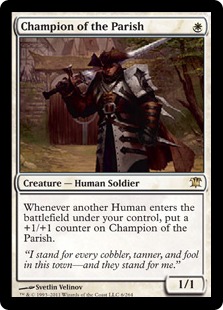 was perfectly designed to destroy Storm back when Storm was popular. Since then I've been expecting it to drop off, but the opposite has happened. I don't know why this is happening because I know that Humans is very vulnerable to Jeskai decks. I absolutely destroyed Humans with Jeskai Tempo every time we crossed paths last year. Humans is filled with small creatures that die to Lightning Bolt at parity, and Spell Queller proved to be a house.
was perfectly designed to destroy Storm back when Storm was popular. Since then I've been expecting it to drop off, but the opposite has happened. I don't know why this is happening because I know that Humans is very vulnerable to Jeskai decks. I absolutely destroyed Humans with Jeskai Tempo every time we crossed paths last year. Humans is filled with small creatures that die to Lightning Bolt at parity, and Spell Queller proved to be a house.
I'll admit that I dismissed the deck. Based on what I saw, it didn't appear that it could hang with the midrange decks of Modern. I was wrong, and Humans has become "The Deck" while control has declined. It's been a struggle to understand why, especially because the current iteration of Humans is not dramatically different from the one back in October.
Metagame Stability
Modern is dynamic and diverse, but that doesn't mean that it cannot or does not stabilize. What I mean is that often we've seen the same decks maintain their positions at the top of the metagame for months on end while there is considerable movement beneath them. This doesn't mean the format is unhealthy by any stretch, just that certain decks have proven that, given what is going on in Modern right now, they are better than other options. Decks may remain Tier 1 for a very long time without causing dynamic equilibrium *cough* Affinity *cough* because their relative position in Tier 1 changes often. As the top decks have been set for several months, I'd argue that we are in a dynamic equilibrium.
Is It Exploitable?
Equilibrium is neither inherently good nor bad. That is determined by context, specifically the fairness of the decks. Given how many fair creature decks are on top, I would argue that this current one is healthy and good. Furthermore, I believe that the stabilization of the metagame around Humans is exploitable. Last year the metagame was in dynamic equilibrium between Eldrazi Tron and Grixis Death's Shadow for most of the summer before Storm disrupted things that fall. This wasn't an easy metagame to attack because it was  polarized between a big-mana deck and a hyper efficient disruption deck. There's a saying from Theros-era Standard that Thoughtseize is better than any answer, and it was on display last year. However, this equilibrium isn't like that one.
polarized between a big-mana deck and a hyper efficient disruption deck. There's a saying from Theros-era Standard that Thoughtseize is better than any answer, and it was on display last year. However, this equilibrium isn't like that one.
The current metagame sees Humans clearly at the top of the pile with Affinity, Jund, and Hollow One elbowing each other for second place. Tron and Eldrazi variants sit in third with Burn not far behind. While there has been some adjustment and movement, these decks have consistently been on top of Modern since February, and the order hasn't changed much since March. This equilibrium consists of a lot of creature decks, three of which (Humans, Affinity, Burn) are very similar creature decks—arguably four if you count RG Eldrazi separately. Against those decks, removal-heavy archetypes like Mardu Pyromancer, UWx Control, or Blue Moon should be favored. They play piles of removal for creatures and have strong disruption against the slow decks. They should be able to topple Tier 1.
The Inexplicable
Why isn't Jeskai Control more of a force? Or Pyromancer for that matter? Jeskai was a Tier 1 deck at the end of last year, and the metagame seems primed for it to thrive. Humans and Affinity are very good matchups, Jund and Eldrazi are no worse than even, and Tron is winnable with a good sideboard. The only truly terrible matchup is Bogles. However, its metagame share continues to decline while its presumptive prey continues to thrive. This doesn't make logical sense, so there must be more going on.
My Theory
I believe that the reason for Humans's continued prominence despite its vulnerabilities comes down to two factors, one intrinsic and the other extrinsic. The intrinsic reason is that Humans can power through a traditional control gameplan because it cannot really be exhausted, which fuels a perception of it being a poor matchup. The extrinsic one is the effect that Hollow One is having on players. Not the format itself per se, but the perceptions of the players. It looks like control is weak against the deck, and this belief fuels an unfounded fear of Hollow One, which keeps players away from actually playing control.
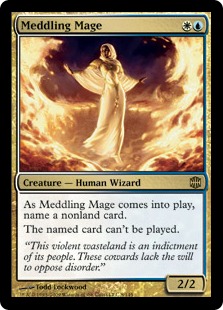 Don't get me wrong, Humans is a powerful deck. We've been over this a few times, but pairing disruption with a clock—especially a clock that doubles as disruption—is powerful. Add to that a high threat density and it appears to be very intimidating for reactive decks to answer Humans. The deck has around 18 lands, four Aether Vial, and 28 creatures. It's very unlikely that the board will ever be completely clear, which can make winning the game a dicey task for a control deck. You never know if a topdecked Thalia's Lieutenant or Mantis Rider will suddenly wreck you.
Don't get me wrong, Humans is a powerful deck. We've been over this a few times, but pairing disruption with a clock—especially a clock that doubles as disruption—is powerful. Add to that a high threat density and it appears to be very intimidating for reactive decks to answer Humans. The deck has around 18 lands, four Aether Vial, and 28 creatures. It's very unlikely that the board will ever be completely clear, which can make winning the game a dicey task for a control deck. You never know if a topdecked Thalia's Lieutenant or Mantis Rider will suddenly wreck you.
The disruption can be easily overcome through efficiency and answer diversity, but the second problem requires adjustment. Rather than take the full control route, you need to transition over to attack once the initial wave is dealt with. This is what Jeskai Tempo is good at, and why I had so much success last year. However, pure control decks struggle with this, and I think this is why they're dropping off.
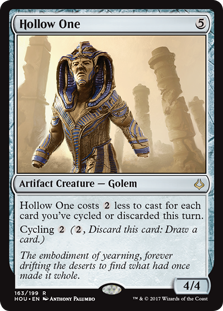 As for Hollow One, I both do and don't understand the fear. Yes, giant creatures on turn three are scary and hard to beat. So is potentially getting wrecked randomly discarding critical cards to Burning Inquiry. It is possible for a great hand to become terrible when you randomly discard all your lands.
As for Hollow One, I both do and don't understand the fear. Yes, giant creatures on turn three are scary and hard to beat. So is potentially getting wrecked randomly discarding critical cards to Burning Inquiry. It is possible for a great hand to become terrible when you randomly discard all your lands.
However, those are pretty low percentage outcomes. I've been across from Burning Inquiry a lot and I've been wrecked by the card as often as my opponent. Granted, my circumstances are unique because I know guys that have been trying to make Waste Not work for years now—but I find that most of the time there's no measurable change to my hand quality, and I end up improved as often as damaged. A well-built control deck should have enough redundancy that it can overcome Inquiry, but the feel-bad aspect keeps players away.
The Jund Factor
One factor that cannot be underestimated is the return of Jund. The deck virtually disappeared last year, but has reemerged since Bloodbraid Elf was unbanned. Jund was a very even matchup for control in the past, but Bloodbraid has changed things. As I've mentioned before, Bloodbraid is very good against control decks, and employs a similar general strategy. I strongly suspect a lot of missing control players are actually on Jund because the deck feels better in the current meta.
The Jace Factor
Another problem is Jace, the Mind Sculptor. Jace may not have made much of an impact on the format as a whole, but it does loom over deckbuilding decisions. When I tested Jace, I found that he excelled in fair midrange games but didn't have much impact against fast decks. In midrange or control games Jace provides an enormous selection advantage and, over time, overwhelming card advantage. By the time Jace comes down against aggro or combo, the 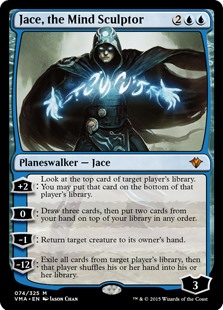 game should already be won. As a result I concluded that Jace would serve as the ultimate trump card for fair decks and push decks to either adopt him or go under him. I would argue this is exactly what has actually happened in Modern this year.
game should already be won. As a result I concluded that Jace would serve as the ultimate trump card for fair decks and push decks to either adopt him or go under him. I would argue this is exactly what has actually happened in Modern this year.
Since Jace was unbanned, my experience has largely validated this conclusion. Jace dominates control mirrors but he's largely irrelevant in other matchups. Jace will dominate an empty board, but there are so many haste creatures running around that Jace is never really safe. Therefore I don't really want Jace most of the time, but I feel compelled to play him anyway. Not having him is backbreaking when your opponent does. I suspect that many players feel the same way, as Jace appears in control decks all over the place, but only in small numbers. I suspect this deckbuilding tension is a significant factor in players not playing control, despite the advantages. Whether correct or not, feeling trapped into making certain deckbuilding decisions is not fun. I personally have opted to avoid actually playing control decks for more than a month for this reason, and I wouldn't be surprised if many potential control pilots were making the same choice.
My Solution
These problems provide parameters to work with, and with some finagling there is plenty of opportunity for control decks. If I were to build a control deck for the current open meta, I would definitely go Jeskai. If I go straight UW it will be harder to shift between roles, because Jeskai's burn makes going beatdown easier. I also prefer not to compete on the same axis in control mirrors and I've seen more UW than Jeskai Control in recent months. Given that counterspells and conditional removal are only situationally good, I would preference hard removal. Considering the format's speed and the resilience of Humans, I want a faster clock. Therefore, if I were to play control, I would play this deck:
Jeskai Tempo, by David Ernenwein
Jeskai Tempo is good enough against Humans that I don't like shifting to a full-control build. Plus I can avoid worrying about Jace and just win. The changes I am making to the maindeck are targeted towards Humans and Hollow One. Counters aren't very powerful against either deck so I cut back and opted for the easier-to-cast Mana Leak over Logic Knot. This does make me weaker against big mana, but I feel that's an acceptable trade-off to have a counterspell that will always work on turn two. The prevalence of graveyard hate in the overall metagame means that Knot will often be poor anyway.
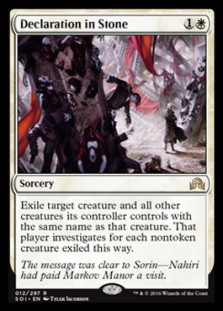 Declaration in Stone seems strange, but it is the right solution to the control problem. As previously mentioned, putting creatures into the graveyard is a liability and the power of Hollow One comes from dumping multiple Hollow Ones, Bloodghasts, and Flamewake Phoenix's into play during the first few turns. Declaration is the cheapest way available to Jeskai to deal with those threats permanently. You also don't care about giving them clues very much. Hollow One has few threats so turning creatures into clues usually just lets them draw more air. Declaration also has the benefit of cleaning up token swarms. It's not the best against Humans, but Declaration can be good against Jund when they play multiple creatures. I've been very impressed in my testing.
Declaration in Stone seems strange, but it is the right solution to the control problem. As previously mentioned, putting creatures into the graveyard is a liability and the power of Hollow One comes from dumping multiple Hollow Ones, Bloodghasts, and Flamewake Phoenix's into play during the first few turns. Declaration is the cheapest way available to Jeskai to deal with those threats permanently. You also don't care about giving them clues very much. Hollow One has few threats so turning creatures into clues usually just lets them draw more air. Declaration also has the benefit of cleaning up token swarms. It's not the best against Humans, but Declaration can be good against Jund when they play multiple creatures. I've been very impressed in my testing.
Seeking Answers
I will be the first to admit I may be reading too much from the apparent stability. There haven't been many events since the Pro Tour that were just Modern. It's been mostly team events and those don't often drive innovation or provide accurate metagame data. Once GP Vegas happens, it may be clear that the metagame has dramatically shifted. In the meantime, I encourage you to challenge the accepted wisdom of this metagame. Humans is a powerful deck, but it's still just a pile of creatures. Prepare correctly and it can be easily picked apart.




I personally am loving this metagame because I have excellent matchups with creature based decks and poor matchups with counterspell decks, I have been using an artifacts & enchantments prison deck and I have found that runed halo is one of the best pieces of removal there is because it’s like a declaration in stone stapled to a surgical extraction that can hit hexproof targets. the only drawbacks are that it performs poorly against tokens and creatures that generate value.
A friend and I have been pondering this lately as well. We both agree that Humans is a good deck, but it just doesn’t feel like the best deck by any means. Humans struggles against the heavy removal decks like midrange and control. Humans often has the problem of drawing the uninteractive half of their deck against a combo deck. Humans doesn’t have a very fast clock compared to other aggro decks and they’re weak to a well placed removal spell and sweepers. I’m not saying Humans is bad… but… Why is it on top?
I did think of one possible reason, though. Many of the Humans pilots I’ve been facing online have seemed pretty inexperienced and new to the format. Perhaps Humans for some reason is a popular choice among players new to the format? Because my win rate against Humans has always seemed to be quite high no matter what deck I’m playing.
It is a possibility that people are picking up humans more for the hype of it being the best than anything else. It was well-represented at the pro tour, which gave it a ton of publicity, and had had similar numbers at recent grand prix.
I think part of it, though, is that while it isn’t the best at anything, it has no giant flaws in the current meta. It isn’t vulnerable to hate like affinity. It isn’t the most disruptive, the fastest, or the most resilient, but it is basically a B+ deck across the board in these categories. AND it doesn’t have an awful ramp matchup like jund or mardu midrange because of its clock and better-aligned disruption (we’ve all seen Tron lose because a land had to enter tapped by now, or Ugin became a nine-cost card).
That’s the thing. Humans is a good deck but it doesn’t stand out. Most of the time the top deck is something exemplary or has certain particularly good matchups that are relatively common. That’s not the case for Humans and I find that very weird.
1: Humans are born with an intricate instinct to focus on things that interrest them.
This is the major reason why we have archetypes. A lot of people have an interrest in winning, and archetypes “seems” to win more than whats played at the kitchentable.
Sometimes our focus becomes the driver of what wins, because if more people play with a deck, the odds for that deck going to the top simply increases with the number of players.
2: Deck mutability is also a factor that has to be counted into the equation.
Affinity is an artisfact deck, it needs artisfacts and it’s succes is limited to what artisfacts are playable at the moment. A mono White deck is largely consisting of white cards.
Humans as a deck is able to use the full colorpalette, but is bound by playing with the creaturetype “human”. Humans as a deck seems to have a large enough cardpool to be able to adapt towards what is played in the meta. Other 2-3 colored decks seems to be very adaptive as well, but few decks run 5 colors. This might be why humans can hang on.
3: What decks are holding back the decks that clearly beat humans?
For humans to be dethroned, the decks able to beat the deck must be able to meet it.
Humans it at the moment played by 10% of the meta, so your odds of running into it will be 1 out of 10 players, which means you will be much more likely to meet something else.
The current meta is wild, with more than 50 active archetypes, and that means your deck is unikely to meet what you most want to. Since most players design their decks to beat the topdecks the bottomfeeders of the meta are really what stops these plans. So the answer will be very unclear as long as we have a wide meta with no decks being played at more than 10% of the field. During times where the best decks in the meta was running 13-14%the field was a lot more narrow and much clearer.